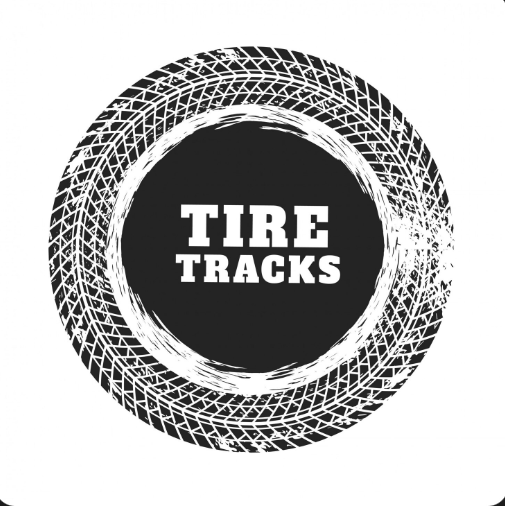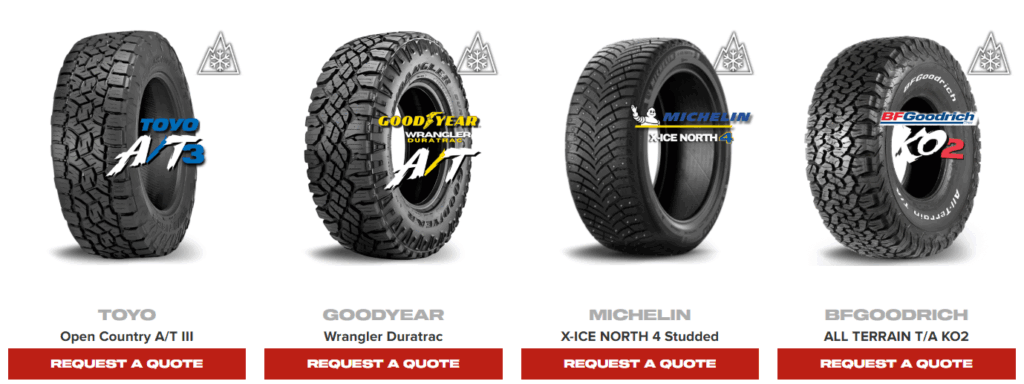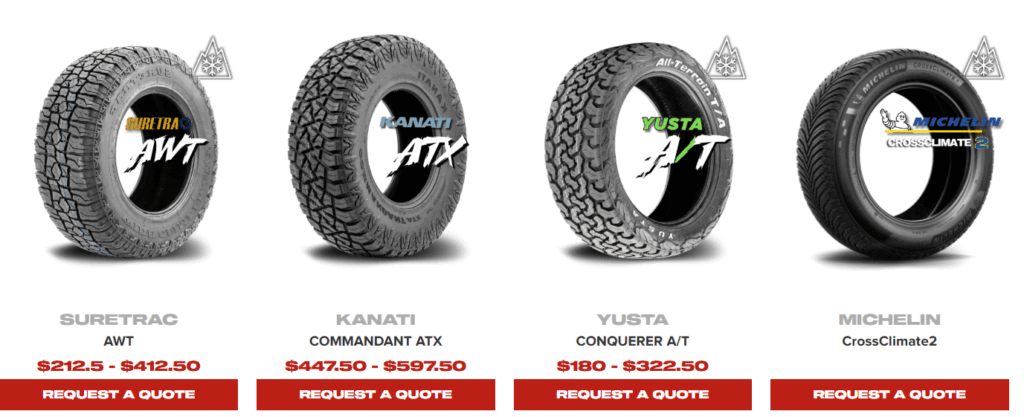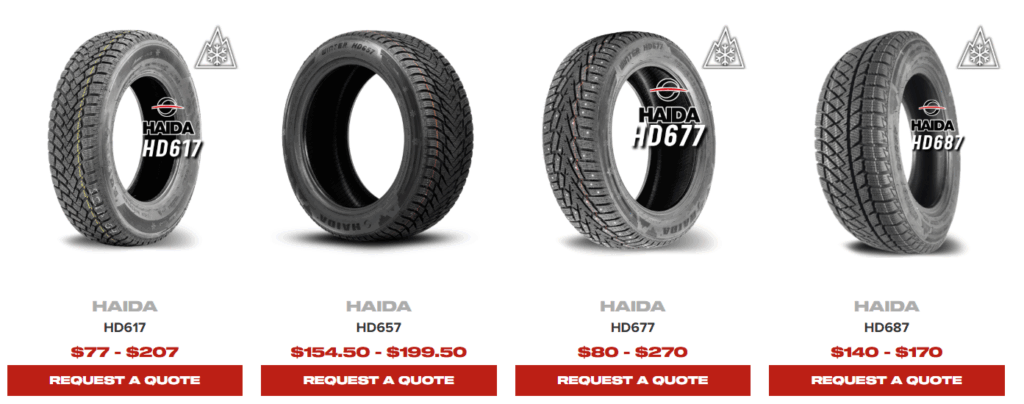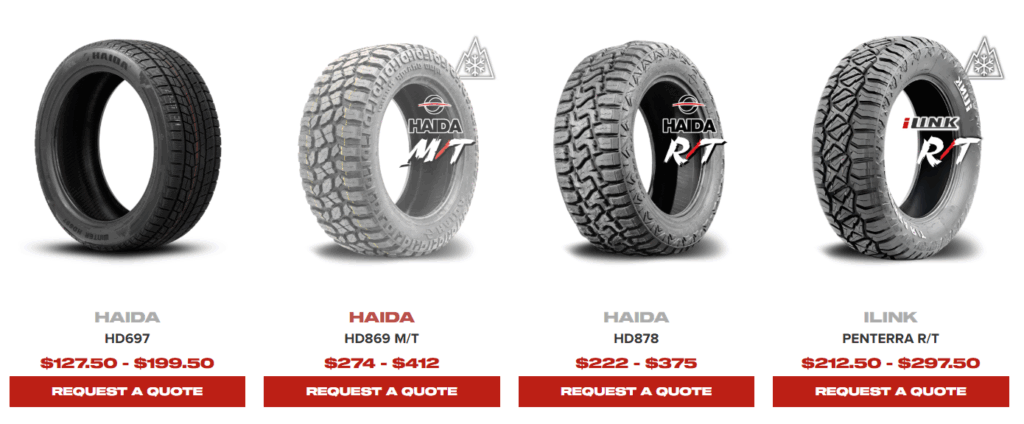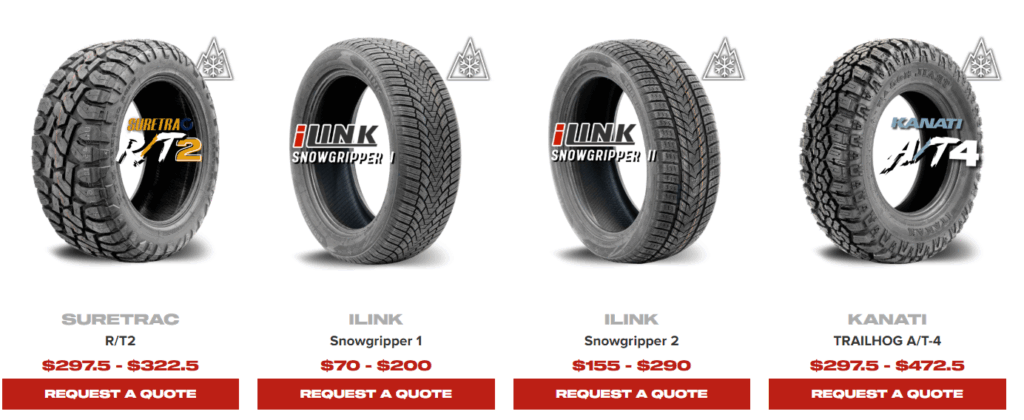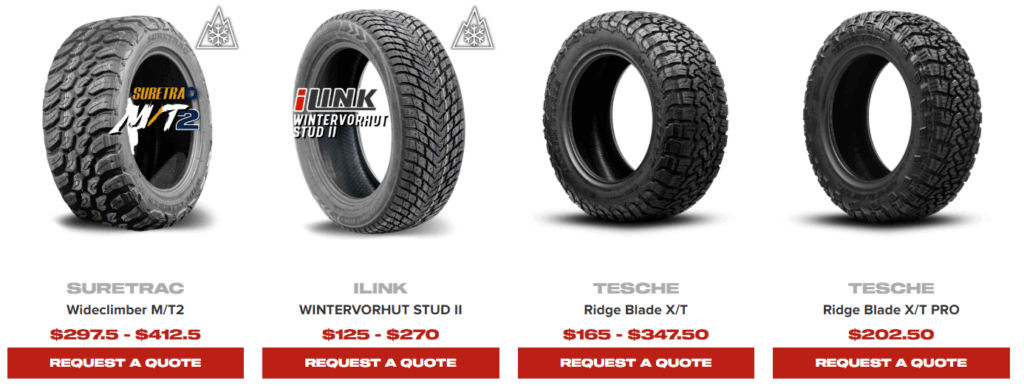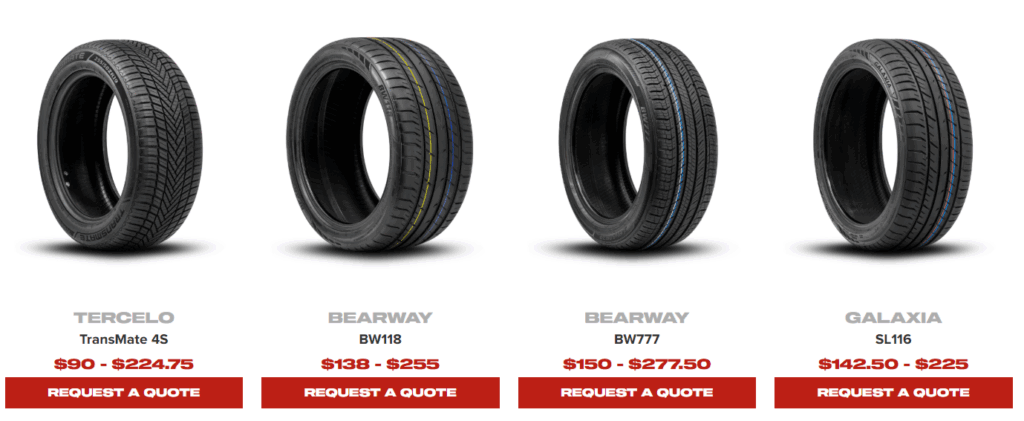When winter hits the Prairies or the Rockies, it doesn’t just bring snow, it brings glare ice, freezing rain, and roads that can change from dry to dangerous in minutes. That’s why so many Canadian drivers turn to pre-studded winter tires for peace of mind. At Canada Custom Autoworks, we know that whether you’re in Calgary, Edmonton, or making the trip through BC’s mountain passes, the right snow tyres with studs can make all the difference. In this guide, we’ll break down studded tires vs winter tires, share the benefits of studded tyres, and help you choose the best studded winter tires Canada has to offer so you can face winter with confidence.
What Exactly Are Pre-Studded Winter Tires?
In simple terms, pre-studded winter tires are snow tires that already have metal studs embedded in their tread when you buy them. Those tiny, tough metal pins are designed to dig into glare ice, breaking through the slick surface and giving your vehicle extra bite when braking or cornering. For Canadian drivers dealing with black ice in Calgary, frozen backroads in Saskatchewan, or coastal freeze in Newfoundland, that extra grip can make all the difference.
Some people call them snow tyres with studs, and others say snow tires with studs - it’s the same product, just a difference in spelling between UK/Canadian and US English. In Canada, you’ll see both terms used interchangeably.
The big advantage of going pre-studded is convenience. Instead of buying regular winter tires and paying for a studding service, which means booking an appointment, waiting for the work, and possibly dealing with uneven stud wear, you get a ready-to-install set straight from the manufacturer. At Canada Custom Autoworks, we keep popular sizes of pre-studded winter tires in stock so our customers can get in, get them mounted, and be road-ready in one stop.
Studded Tires vs. Regular Winter Tires
The core difference between studded winter tires and regular winter tires lies in their performance on ice. Studded models use small metal pins to dig into frozen surfaces, delivering a stronger grip and shorter braking distances in harsh conditions, a big advantage on black ice in Edmonton, windswept highways in Manitoba, or icy mountain passes in BC. Non-studded winter tires rely solely on their rubber compound and tread pattern, which still provide excellent traction in snow and slush but can’t quite match studs on glare ice.
Here’s how they compare across common Canadian winter driving conditions:
| Feature / Condition | Studded Winter Tires | Regular Winter Tires (Non-Studded) |
| Performance on Ice | Metal studs bite into ice for superior grip and shorter stopping distances. Ideal for black ice and hard-packed snow. | Good grip from the tread and rubber compound, but less effective than studs on glare ice. |
| Performance in Deep Snow | Combines aggressive tread with studs for extra bite when snow becomes compacted and icy underneath. | Aggressive tread works well in deep snow; no studs, so less advantage on icy base layers. |
| Performance in Slush / Wet Conditions | Similar to non-studded tires, tread design is the main factor in slush handling. | Performs equally well in slush if the tread design is optimized for water evacuation. |
| Noise & Comfort | Louder ride due to metal studs, especially on dry pavement. | Quieter and smoother on bare roads. |
| Best For | Rural highways, icy roads, frequent freeze–thaw cycles. | Urban or milder areas where roads are cleared quickly and ice is less common. |
Are studded winter tires better? In icy parts of Canada, yes, especially for drivers in rural or high-risk areas. But for cities with prompt snow removal and less ice, a quality set of non-studded winter tires can offer a safer and quieter ride. At Canada Custom Autoworks, we guide customers toward the option that best suits their climate, driving style, and budget.
The Benefits of Studded Tires in Canadian Conditions
Studded winter tires and snow tyres with studs offer distinct advantages in the harsh and varied winter climates found across Canada. From icy city streets to remote rural highways, they provide performance benefits that go beyond what regular winter tires can achieve.
1. Better Braking on Icy Intersections
- Metal studs penetrate the top layer of ice, creating additional friction.
- Shorter stopping distances compared to non-studded winter tires, especially during freeze–thaw cycles.
- Greater control when approaching traffic lights, stop signs, and pedestrian crossings.
2. Added Confidence on Untreated Highways
- Consistent grip on hard-packed snow and black ice.
- Reduced risk of sliding or fishtailing when changing lanes or making sudden maneuvers.
- Ideal for regions where road maintenance may be delayed or inconsistent.
3. Safety for Long Commutes and Rural Drives
- Reliable traction in areas where snow and ice remain on the road for extended periods.
- Enhanced stability on winding rural roads and less-travelled routes.
- Lower chance of getting stuck or losing control in remote locations.
When icy conditions are a regular part of winter driving, studded winter tires can deliver the extra margin of safety needed for a smoother, more secure journey.
Best Studded Winter Tires for Canada
Choosing the best studded tyres for winter depends on driving conditions, vehicle type, and regional climate. Here are some top-rated options and considerations for Canadian roads.
1. Recommended Models
- Nokian Hakkapeliitta 10 Studded – Exceptional grip on ice, dual-stud technology for stability in extreme cold.
- Bridgestone Blizzak LT with studs – Designed for trucks and SUVs, strong performance on icy highways.
- Michelin X-Ice North 4 – Advanced stud placement for balanced handling and reduced road noise.
- General Tire Altimax Arctic 12 Studded – Reliable traction and good value for mixed winter conditions.
2. Local Availability – Best Studded Winter Tires Canada
- Most major tire retailers stock popular studded models in common sizes from October through early winter.
- In northern regions, studded tires may be available year-round due to extended winter seasons.
- Limited stock in southern cities means early shopping is recommended before peak demand.
3. Regional Considerations
- BC Mountain Passes – Look for models with maximum stud density for steep, icy climbs and descents.
- Prairie Flatlands – Prioritize stability at highway speeds and resistance to crosswinds on open roads.
- Atlantic Coastal Roads – Choose studded tires with excellent wet grip as well as ice performance to handle freeze–thaw and slushy conditions.
How to Choose Studded Tyres?
Selecting the right studded winter tires is about more than just picking a brand - it’s about matching the tire’s design to your driving environment, vehicle type, and comfort preferences. Factors like stud configuration, tread pattern, and size all play a role in how well your tires will perform in Canadian winter conditions.
| Selection Factor | What to Look For | Why It Matters |
| Driving Conditions | Urban: quieter models with moderate stud density. Rural/Highway: snow tyres with studs designed for long-distance stability. Mountainous terrain: high stud counts and aggressive tread. | Ensures the tire’s grip and handling match the challenges of your environment. |
| Vehicle Type | Cars: lighter stud patterns, narrower widths. SUVs/Crossovers: reinforced sidewalls, balanced stud design. Trucks: heavy-duty studded tyres built for towing and icy worksites. | Different vehicles require different load capacities and traction designs. |
| Stud Configuration | Even distribution and multi-angle studs. Factory-installed studs preferred. | Improves braking, cornering, and wear consistency. |
| Size & Load Rating | Match the manufacturer’s recommended size and load index. | Correct sizing ensures stability, safety, and prevents premature wear. |
| Noise & Comfort | Lower stud counts for quieter ride; premium compounds for reduced vibration. | Balances performance with driving comfort, especially on dry pavement. |
The right studded tyres will give you the safety, handling, and confidence needed to handle everything from icy intersections to long winter commutes.
Provincial Laws on Studded Tires
Rules for studded winter tires vary across Canada, with each province and territory setting its guidelines on when and where they can be used. These regulations are designed to balance winter safety with the potential road wear caused by metal studs.
Key provincial guidelines:
- British Columbia – Allowed from October 1 to April 30. Up to 130 studs per tire for vehicles under 4,600 kg; 175 studs for heavier vehicles.
- Alberta – No restrictions on use; studs can be used year-round.
- Saskatchewan – Allowed without seasonal limits, but only for vehicles under 10,000 kg GVW.
- Manitoba – Permitted from October 1 to April 30.
- Ontario – Legal only in Northern Ontario (north of Parry Sound and Nipissing) year-round; banned in Southern Ontario.
- Quebec – Required for all passenger vehicles from December 1 to March 15; studs allowed during this period.
- Newfoundland & Labrador – Allowed from November 1 to May 31.
- New Brunswick – Allowed from October 15 to May 1.
- Nova Scotia – Allowed from October 15 to May 31.
- Prince Edward Island – Allowed from October 1 to May 31.
- Territories (Yukon, NWT, Nunavut) – No restrictions due to extreme winter conditions.
Knowing these rules ensures your snow tyres with studs are legal for your region and that you’re ready for inspections if crossing provincial borders during winter.
Canada Custom Autoworks is a trusted name in wheels, tires, and automotive accessories, serving drivers across Western Canada. With locations in Alberta, British Columbia, and Saskatchewan, we specialize in providing the right products for Canadian driving conditions, from studded winter tires for icy highways to all-terrain setups for off-road adventures.
Our team combines hands-on experience with industry knowledge to help customers choose tires, wheels, and accessories that fit their needs, style, and budget. Whether you’re upgrading for performance, safety, or appearance, Canada Custom Autoworks offers expert advice, competitive pricing, and professional installation.
